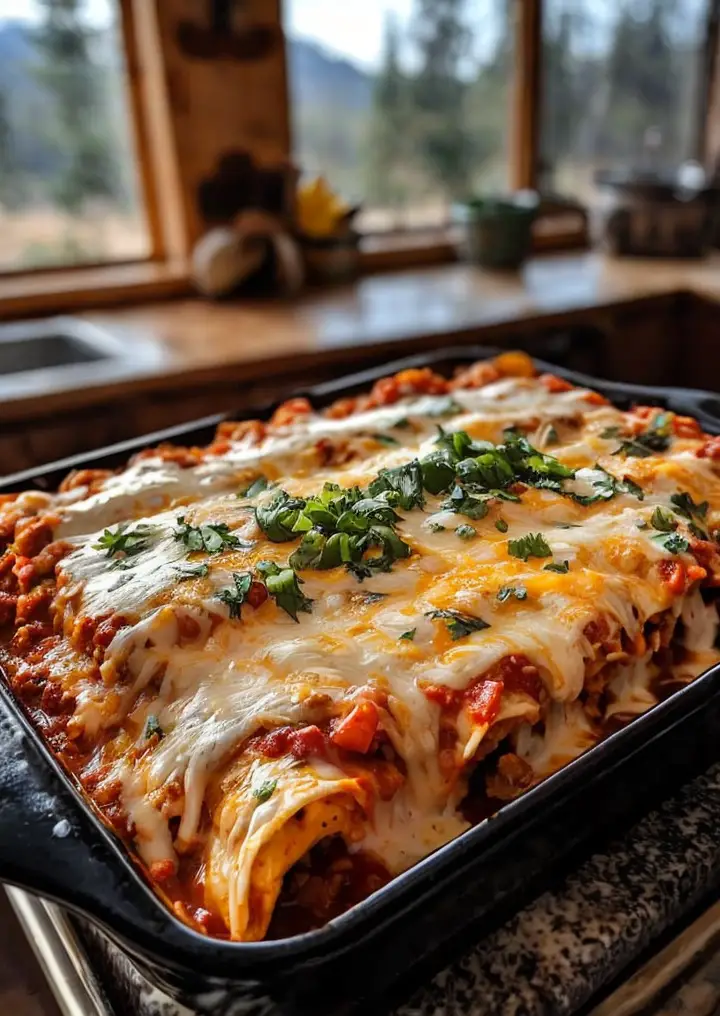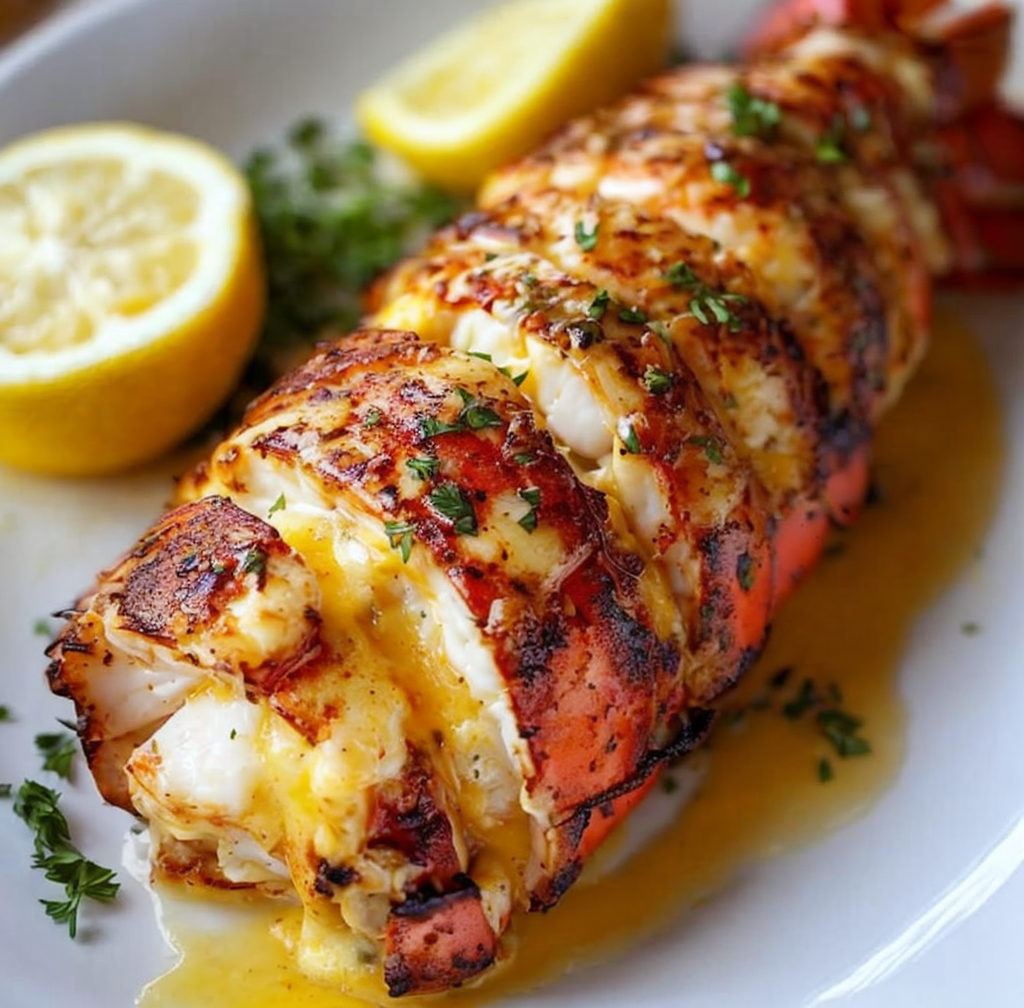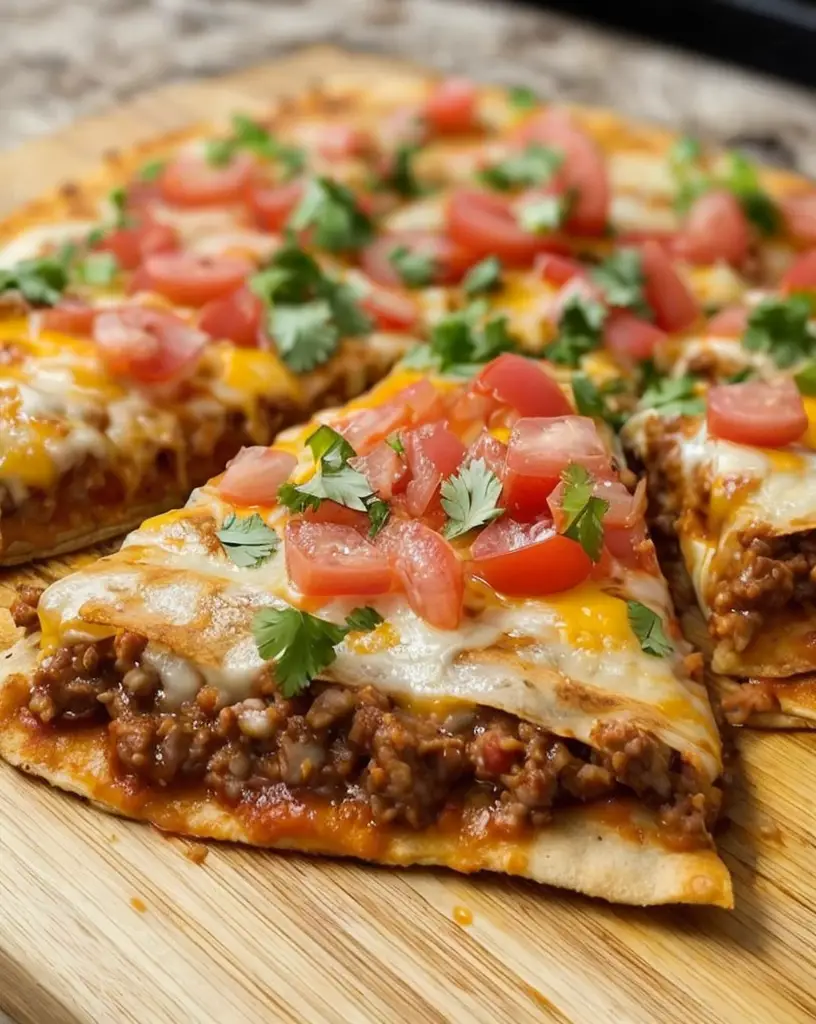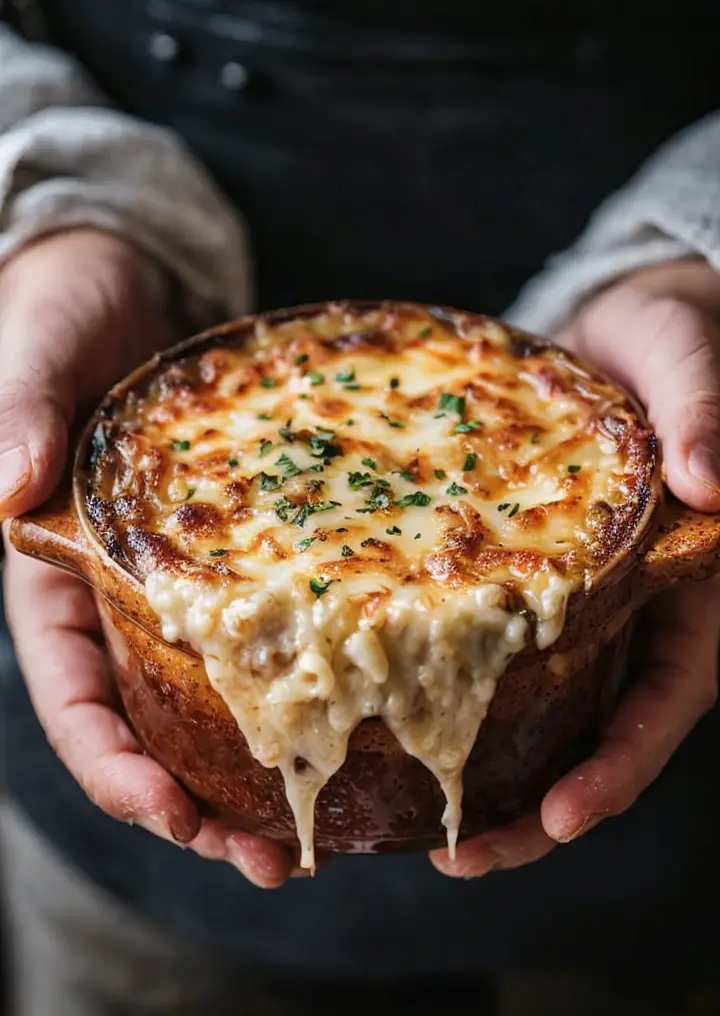Cheesy Enchilada Chili: A Comforting Fusion Delight
Cheesy Enchilada Chili brings together the best of two worlds: the hearty comfort of chili and the zingy, cheesy flavor of enchiladas. Imagine a bowl of warm, robust chili simmered with spices, layered with gooey cheese, and filled with tender beans, meat, and vibrant vegetables. It’s enough to warm your soul and satisfy your cravings for both Mexican and American comfort food. This dish is perfect for chilly evenings or potlucks, providing a satisfying meal that everyone will love.
The enchanting aroma of spices wafts through the air as the chili cooks, setting the stage for a delightful dining experience. With each spoonful, you’ll encounter a delightful medley of textures – from the creamy cheese melting against tender meat and beans to the slight crunch of set vegetables. This Cheesy Enchilada Chili doesn’t just fill your belly; it’s a hearty dish that fuels your spirit.
Quick Recipe Highlights
- Flavor Profile: This dish is a harmonious blend of smoky chili flavors with hints of cumin, topped with melted cheese for an irresistible creaminess.
- Texture: The chili presents a combination of smoothness from the cheese and a satisfying bite from the beans and vegetables.
- Aroma: The dish is fragrant with spices like chili powder and cumin, mingling with the warmth of the cheese as it bakes.
- Visual Appeal: A vibrant mix of colors from the red tomatoes, green bell peppers, and golden cheese makes it as pleasing to the eye as it is to the palate.
- Skill Level Needed: An easy recipe suitable for beginner cooks, allowing everyone to enjoy homemade comfort food.
- Special Equipment: A large pot or Dutch oven is perfect for making this chili, alongside basic kitchen utensils.
Recipe Overview
- Difficulty Level: This Cheesy Enchilada Chili is classified as easy, making it perfect for cooks of any skill level. You’ll find that it requires no special techniques, just basic chopping and stirring.
- Category: This dish is suitable for a main course, especially on a cold day or a festive gathering like game day or family dinners.
- Cuisine: With its roots in Mexican culinary traditions, this recipe draws on the rich flavors of enchiladas while incorporating an American-style chili twist.
- Cost: This recipe is budget-friendly, with ingredients such as beans, tomatoes, and spices readily available and affordable.
- Season: Ideal to make in fall and winter when you crave something warming, this chili also works beautifully for gatherings all year round.
- Occasion: Perfect for casual get-togethers, family dinners, or as a comforting meal after a long day.
Why You’ll Love This Recipe
The rich, comforting taste and texture of the Cheesy Enchilada Chili make it an unforgettable dish. Each bite is packed with warmth, from the spices enveloping your palate to the creaminess of the melted cheese that ties everything together. The blend of flavors not only satisfies hunger but also delivers a burst of excitement, making it a dish worth sharing with loved ones.
Convenience is another key reason to embrace this recipe. With a prep time of just 15 minutes, you can have dinner cooking while you unwind after a busy day. This one-pot meal minimizes cleaning, offering maximum comfort with the least hassle, making it ideal for busy weeknights.
Nutritionally, Cheesy Enchilada Chili does not skimp on benefits. Rich in protein from the beans and any meat you may choose to include, it also packs plenty of fiber, vitamins, and minerals from the vegetables. This chili helps to sustain you through the day, providing energy without heaviness.
Socially, this dish is a true crowd-pleaser. Its emphasis on communal dining and sharing makes it perfect for parties and family gatherings. Set out some toppings, and let everyone customize their bowls; it’s an excellent way to encourage conversation and mingling.
Cost-effectively, Cheesy Enchilada Chili stands out with its simplicity and affordability. Staple ingredients make it accessible to anyone, allowing you to serve a hearty, delicious meal without breaking the bank. This balancing act of flavor, comfort, and convenience is why you’ll find this recipe becoming a staple in your cooking repertoire.
Historical Background and Cultural Significance
Cheesy Enchilada Chili embodies the gastronomic clash of cultures that occurs in many kitchens. Its roots may be traced back to the traditional Mexican enchilada, which consists of tortillas filled with various ingredients and covered with sauce. Chili itself has been treasured in American cuisine, particularly in the Southwest, making this recipe a delicious fusion that celebrates both heritages.
Culturally, chili holds a sentimental place in American homes, often being featured in family recipes passed down through generations. The enchilada, too, tells a story of rich flavors, showcasing the influence of indigenous ingredients and techniques. The combination of these two beloved dishes in Cheesy Enchilada Chili signifies a unifying aspect of food – bringing people together across borders over a shared love of hearty, flavor-packed meals.
The evolution of this recipe likely came about during casual family gatherings where both chili and enchiladas were favorites. Combining them saves time while maximizing the flavors that many of us love. Through these blends, new traditions and dishes are born, giving us yet another reason to celebrate diverse culinary heritages.
Regional variations abound, with modifications commonly made to suit local tastes and available ingredients. Whether one adds corn, changes up the spices, or plays with the level of heat, Cheesy Enchilada Chili is a canvas that allows for creativity, showcasing the innovative spirit of home cooks everywhere.
Ingredient Deep Dive
- Beans: Beans are often considered a staple in many cultures, especially in Latin and American cuisines. They are a fantastic source of protein and dietary fiber, contributing to heart health and sustained energy. When choosing beans for Cheesy Enchilada Chili, look for varieties like black beans or pinto beans, and ensure they are stored in a cool, dry place for maximum freshness.
- Chili Powder: Chili powder brings the heat and depth of flavor necessary for this recipe. It’s a blend of spices that often includes dried chilies, garlic powder, and cumin, each playing a role in savory complexity. When purchasing, choose high-quality chili powder for the best results and store it in an airtight container. Experimenting with homemade blends is a fantastic way to customize your spice level.
Common Mistakes to Avoid
- Overcooking the chili: Cooking too long can lead to mushy beans and loss of texture. Aim for a balance where all ingredients are just tender.
- Using too little seasoning: Chili requires robust seasoning. Under-seasoning can render it bland, so taste and adjust regularly.
- Skipping the cheese: Cheese adds vital creaminess; don’t skip it! Choose a good melting cheese like cheddar.
- Ignoring resting time: Allowing chili to sit for a few minutes after cooking can enhance flavor melding.
- Not adjusting for spice: Adjust spices according to your taste preference before serving; add more chili powder or hot sauce if needed.
- Using canned beans incorrectly: Rinsing and draining canned beans helps reduce sodium and improves texture.
- Overloading on toppings: While toppings are fun, too much can overwhelm the chili’s flavors; add sparingly.
- Choosing poor quality tomatoes: Opt for high-quality canned tomatoes, preferably San Marzano for balanced sweetness and acidity.
- Forgetting prep steps: Failing to chop ingredients uniformly can cause uneven cooking; ensure similar sizes for even cooking.
- Not checking for doneness: Always check the dish for final doneness before serving to ensure everything is cooked properly.
Essential Techniques
- Sautéing: This technique helps to develop flavors by cooking aromatics like onions and garlic in oil. To master it, use medium heat until the onions are translucent and fragrant. Common pitfalls include overcrowding the pan, which can lead to steaming instead of browning; ensure you have enough space in the pan for even cooking.
- Simmering: Simmering allows ingredients to meld beautifully while cooking slowly. Maintain a gentle simmer with small bubbles and avoid bringing your chili to a rolling boil as it can break down the ingredients too much. Visual cues for success include a lightly bubbling surface and a rich aroma.
Pro Tips for Perfect Cheesy Enchilada Chili
- Use freshly grated cheese to ensure optimal melt and flavor; pre-shredded varieties often contain anti-caking agents that can affect the texture.
- Blend in a tablespoon of tomato paste for added richness and depth of flavor that complements the spices.
- Experiment with adding different types of protein like shredded chicken or ground turkey for variations.
- Let the chili rest after cooking; this helps the flavors develop and taste even better when reheated.
- Add a splash of hot sauce to the finished dish for a sudden burst of unexpected heat.
- Serve with a variety of toppings like jalapeños, sour cream, or corn chips for texture contrast.
- Consider adding turmeric for anti-inflammatory benefits and an extra layer of earthiness.
- Use leftover chili as a customizable filling for burritos or enchiladas to withhold the essence of the chili in new forms.
Variations and Adaptations
Cheesy Enchilada Chili can be transformed to cater to seasonal ingredients, utilizing fresh vegetables during summer for a lighter take. For an autumn twist, incorporate roasted squash for sweetness, and in winter, consider adding hearty root vegetables.
Those with dietary modifications can easily adapt this recipe; replacing meat with lentils or cauliflower for a vegan option retains the flavors while accommodating dietary needs. For those seeking bolder flavors, try adding chili peppers or salsas with varied heat levels.
If you’re feeling creative, consider using different cheeses such as pepper jack for a spicy kick, or mixing in flavors with contrasting textures by experimenting with crunchy toppings like fried tortilla strips.
Lastly, presentation can be an artistic endeavor. Consider layering the chili with cheese and herbs in individual baking dishes for a rustic appeal or serving it in vibrant tortilla bowls for a fun and festive touch.
Serving and Presentation Guide
For an appealing presentation of Cheesy Enchilada Chili, consider using colorful bowls to highlight the vibrant ingredients. Creative garnishing options such as chopped cilantro, diced avocados, and finely grated cheese significantly enhance visual allure.
You might want to accompany the dish with sides of tortilla chips, sour cream, or fresh salads to provide a pop of color and flavor contrast on the plate.
Presenting the chili steaming in bowls will not only elevate its temperature but also enhance the aroma that guests will appreciate. Always serve the chili hot for the best texture and flavor experience.
When serving, consider using a ladle for portion control, ensuring everyone receives a balanced mix of beans, meat, and peppers. This promotes equitable sharing while keeping the servings manageable, especially during gatherings.
Wine and Beverage Pairing
Pair your Cheesy Enchilada Chili with wine that complements its flavors; a medium-bodied red, such as a Syrah or a Zinfandel, provides a delightful counterbalance to the spice. These wine flavors harmoniously mingle with the chili’s richness, enhancing your meal experience.
For non-alcoholic options, offer a chilled horchata or refreshing limeade to cleanse the palate between bites.
If coffee is your preference, serving a dark roast with light notes can add a beautiful but unexpected pairing, intensifying the chili’s flavors, while herbal tea provides a calming finish to the meal.
Be sure to consider the temperature of your beverages as well. Chilled drinks work wonderfully with the warm meal, providing a refreshing contrast that enhances the overall enjoyment.
Storage and Shelf Life
For proper storage of Cheesy Enchilada Chili, cool it completely before transferring it to an airtight container. Properly stored, it stays fresh in the fridge for up to four days, making it a great option for meal prepping.
When freezing, portion the chili in freezer-safe bags or containers. Ensure you leave some room for expansion, and it can last for up to three months in the freezer.
Before reheating, always check for signs of spoilage; if you notice any off-smells or changes in texture, it’s best to discard it. To reheat, gently warm it on the stove or microwave until heated through, stirring occasionally.
When ready to use, adding a splash of broth can enhance its initial flavor and prevent dryness from freezing.
Make Ahead Strategies
To prepare Cheesy Enchilada Chili ahead of time, chop the ingredients and store them separately in the fridge. The chili base can be made a day in advance and stored until needed.
For optimal flavor, consider letting the chili develop overnight, as flavors meld and mature beautifully. Reheat gently the next day, with the addition of fresh herbs or toppings to revitalize the dish.
If possible, pre-cook the proteins you wish to add and store them in the fridge or freezer to save time during the busy week.
When ready to serve, simply assemble ingredients in a single pot and cook until heated, ensuring minimal effort and impact on family time.
Scaling Instructions
To halve this recipe, simply cut all ingredients and cooking times in half, which is perfect for smaller households or when trying the dish for the first time.
If doubling or tripling, take care to use larger pots, as the increased contents may require bigger equipment.
Adjustments in timing might be necessary; larger volumes might take slightly more time to heat through, so ensure to monitor closely for doneness.
For any leftovers, consider storing portions separately or combining based on meals throughout the week to enhance meal diversity without unnecessary waste.
Nutritional Deep Dive
Cheesy Enchilada Chili is a well-balanced dish featuring macronutrients vital for energy. A single serving contains a good mix of proteins from beans and meat, carbohydrates from tomatoes and beans, and healthy fats from cheese.
On the micronutrient side, ingredients like bell peppers and tomatoes are excellent sources of vitamins A and C, supporting immune functions, while beans offer essential minerals such as iron and magnesium for bodily functions.
Evaluating dietary considerations, it’s suitable for many meal plans, especially when controlled for sodium and portion sizes. A balanced meal can contribute to weight management, providing satisfaction without excessive calories.
Portion analysis suggests that recognizing serving sizes can help maintain a healthy lifestyle while indulging in comfort food.
Dietary Adaptations
Cheesy Enchilada Chili can be made gluten-free by ensuring you use certified gluten-free spices and stock. For a dairy-free twist, replace traditional cheese with nut-based options or nutritional yeast for added flavor without the dairy.
Vegan adaptations are simple; just remove the meat and use lentils or mushrooms while keeping the dish flavorful with vegetables and spices.
For low-carb and keto diets, skip the beans and opt for grilled vegetables as a hearty replacement while tweaking spice levels to enhance flavors.
For those following a paleo diet, focus on using fresh, whole ingredients and avoiding canned products. With slight adjustments, anyone can nourish their preferences.
Troubleshooting Guide
If your Cheesy Enchilada Chili turns out too thick, consider adding a splash of broth or water to reach the desired consistency. Conversely, if it is too watery, let it simmer uncovered to reduce excess liquid.
In instances where the flavors seem unbalanced, taste and adjust seasoning as necessary. Adding salt or a hint of acidity, such as lime juice, can brighten the dish.
If the cheese does not melt correctly, shredded cheese ensures even melting. Be cautious not to cook at too high of a temperature, as it may cause the fat to separate.
Timing may be an issue; if the chili seems undercooked, give it more time while keeping an eye on flavor maturation.
Lastly, if ingredients are unfamiliar or unwanted, consider adjusting the flavor profile or textures to your palate with suitable substitutes that fit your liking.
Recipe Success Stories
Many readers often choose to customize their Cheesy Enchilada Chili, resulting in fantastic variations. One community member shared their success with a vegetarian version loaded with fresh zucchini and bell peppers, making it suitable for family gatherings without meat.
Others have praised its versatility, submitting feedback on using leftovers in burritos. The hearty recipe stands out in the kitchen, leading to a continuous flow of rave reviews and requests for meal-sharing.
A reader submitted a photo that showcased the chili garnished beautifully with fresh cilantro and avocado. This encourages aspiring cooks to elevate their presentation game while making the most out of simple ingredients.
Engagement in the community is essential as contributing ideas and photography tips can inspire others to explore their culinary creativity using this simple, adaptable recipe.
Frequently Asked Questions
Can I make Cheesy Enchilada Chili in advance?
Absolutely! Preparing this chili a day in advance allows flavors to meld beautifully. Store it in the fridge, and simply reheat it before serving. This ahead-of-time approach works wonders for busy evenings.
What can I use instead of cheese in this recipe?
You have several delicious alternatives! Nutritional yeast can provide a cheesy flavor without dairy, while cashew cream or dairy-free cheese options serve as excellent substitutions for richness.
Can I add more vegetables to the chili?
Definitely! Feel free to include any of your favorites such as corn, carrots, or diced sweet potatoes. Adjusting the recipe to include more vegetables can add both nutrition and flavor.
Is this chili spicy?
The spiciness depends on the type of chili powder and additional hot ingredients you choose to add. For milder versions, use less seasoning or mild varieties of chili pepper while adjusting to your desired heat level.
Can I freeze leftover chili?
Yes! Once cooled, portion the chili into airtight containers and freeze it for up to three months. For the best results, reheat gently after thawing, and you can even add a bit of broth to revive it.
What can I serve with Cheesy Enchilada Chili?
This hearty dish pairs wonderfully with tortilla chips, cornbread, or a fresh green salad. You can also add toppings like sour cream, avocado, or cilantro to enhance the experience.
How can I make my chili thicker?
If you find your chili too thin, let it simmer uncovered to allow excess liquid to evaporate, or add a teaspoon of cornstarch mixed with water for quick thickening without compromising flavor.
What kind of beans can I use in this recipe?
Both black beans and pinto beans work beautifully in Cheesy Enchilada Chili, but feel free to mix and match depending on your taste preferences or what’s available in your pantry.
Can this recipe be made in a slow cooker?
Yes! Combine all ingredients in a slow cooker, and cook on low for 6-8 hours. Just add cheese during the last 15-30 minutes to let it melt perfectly.
Is Cheesy Enchilada Chili suitable for meal prepping?
Absolutely! Make a large batch at the beginning of the week, and portion it out for lunches or dinners throughout the week. The flavors only grow better as it rests, making it perfect for meal prep!
Additional Resources
If you enjoyed making Cheesy Enchilada Chili, you may want to explore related recipes such as Mexican Street Corn or Slow Cooker Taco Soup that offer similar flavor profiles.
Consider reviewing technique guides focused on chopping skills or mastering different cooking methods for further culinary exploration. You can also dive deeper into ingredient knowledge, exploring nutritional profiles and benefits through various educational resources.
Incorporating seasonal variations into your cooking can elevate the experience, allowing you to adapt dishes according to availability and inspire creativity in the kitchen.
Join the Conversation
We love to hear from you! Share your photos and experiences of making Cheesy Enchilada Chili on social media platforms. Use the hashtag #EnchiladaChiliSuccess to connect with fellow food enthusiasts.
Feel free to leave a review or suggestions for variations that you’ve tried. Over time, community engagement enriches our cooking experiences and inspires creativity.
Dominating the conversation with both successes and learning moments helps maintain an active community where everyone can grow and share in the culinary adventure together.
The Recipe
Cheesy Enchilada Chili
Serves: 6
Prep Time: 15 mins
Cook Time: 30 mins
Total Time: 45 mins
Kitchen Equipment Needed
- Large pot or Dutch oven
- Wooden spoon or spatula
- Cutting board
- Chef’s knife
- Measuring cups and spoons
Ingredients
- 1 lb ground beef or turkey
- 1 can (15 oz) black beans, drained and rinsed
- 1 can (14.5 oz) diced tomatoes
- 1 cup beef or vegetable broth
- 1 onion, diced
- 2 cloves garlic, minced
- 1 green bell pepper, diced
- 2 tablespoons chili powder
- 1 teaspoon cumin
- Salt and pepper to taste
- 2 cups shredded cheddar cheese
- Sour cream and cilantro for serving (optional)
Directions
- In a large pot, heat over medium heat. Add the ground beef or turkey and cook until browned. Drain any excess fat.
- Add the diced onion, garlic, and green bell pepper. Sauté for about 5 minutes until softened.
- Stir in the chili powder, cumin, salt, and pepper, cook for an additional minute.
- Add in the canned tomatoes, black beans, and broth. Bring to a simmer and reduce heat to low.
- Let the chili simmer for 20-25 minutes until all flavors meld together.
- Stir in 1 cup of cheese until melted and incorporated.
- Serve hot topped with remaining cheese, sour cream, and cilantro if desired.
Recipe Notes
- Feel free to substitute the ground meat with a meat alternative for a vegetarian or vegan option.
- Adjust the spice level by adding more chili powder or fresh jalapeños.
- This recipe can be made ahead of time and stored in the fridge or frozen for later use.




